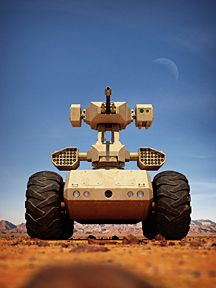Networks of autonomous robots will someday transform warfare,but significant hurdles remain.
Two small planes fly low over a village,methodically scanning the streets below. Within minutes, they spot their target near the edge of town. With no way to navigate through the streets, they radio for help. Soon after, a metallic blue SUV begins moving cautiously but purposefully along the dirt roads leading to town, seeking out the target’s GPS coordinates. Meanwhile, the planes continue to circle overhead, gathering updated information about the target and its surroundings. In less than half an hour after the planes take to the sky, the SUV has zeroed in on its quarry. Mission accomplished.
Last fall, Research team fielded these vehicles at Fort Benning, Ga., during the U.S. Army’s Robotics Rodeo. The two quarter-scale Piper Cub aircraft and the Porsche Cayenne operated without any humans at the controls. Instead, each robot had an onboard computer running collaborative software that transformed the three machines into an autonomous, interoperable system.
The demonstration may sound simple–the target was just a tarp staked to the ground–but had this been the streets of Kabul or Baghdad, where any pile of debris can conceal a deadly improvised explosive device, such autonomous tracking robots in the future could help keep soldiers out of harm’s way. Indeed, military leaders have increasingly embraced the use of unmanned aerial vehicles (UAVs) and other robotic systems over the past decade, to handle the “three D’s”: the dull, dirty, and dangerous tasks of war. Back in 2000, the U.S. Department of Defense (DOD) had fewer than 50 UAVs in its inventory; by early 2010, it had more than 7000. In 2009, the U.S. Air Force started training more pilots to operate unmanned systems than to fly fighters and bombers. And according to market research firm ABI Research, 65 countries now use military robots or are in the process of acquiring them.
The ranks of battlefield robots will only grow: The U.S. Congress has mandated that by the year 2015, one-third of ground combat vehicles will be unmanned, and the DOD is now developing a multitude of unmanned systems that it intends to rapidly field. Meanwhile, thousands of robotics researchers worldwide are making impressive gains in networking robots and boosting the sophistication and autonomy of these systems.
Despite the advances in both their performance and safety, these robots are still far from perfect, and they routinely operate in situations for which they may not have been designed and in which their responses cannot always be anticipated. Some of the DOD’s most advanced UAVs carry dozens of sensors, including high-resolution night-vision cameras, 3-D imagers, and acoustic arrays. Yet most cannot distinguish a sleeping dog from a bush, even at high noon. Humans are still needed to operate the vehicles, interpret the data, and coordinate tasks among multiple systems. If we are ever to see fully autonomous robots enter the battlefield–those capable of planning and carrying out missions and learning from their experiences–several key technological advances are needed, including improved sensing, more agile testing, and seamless interoperability. Even then, a basic question will remain: How can we equip these robots to make critical decisions on their own?
Source: http://spectrum.ieee.org/robotics/military-robots/autonomous-robots-in-the-fog-of-war/0

